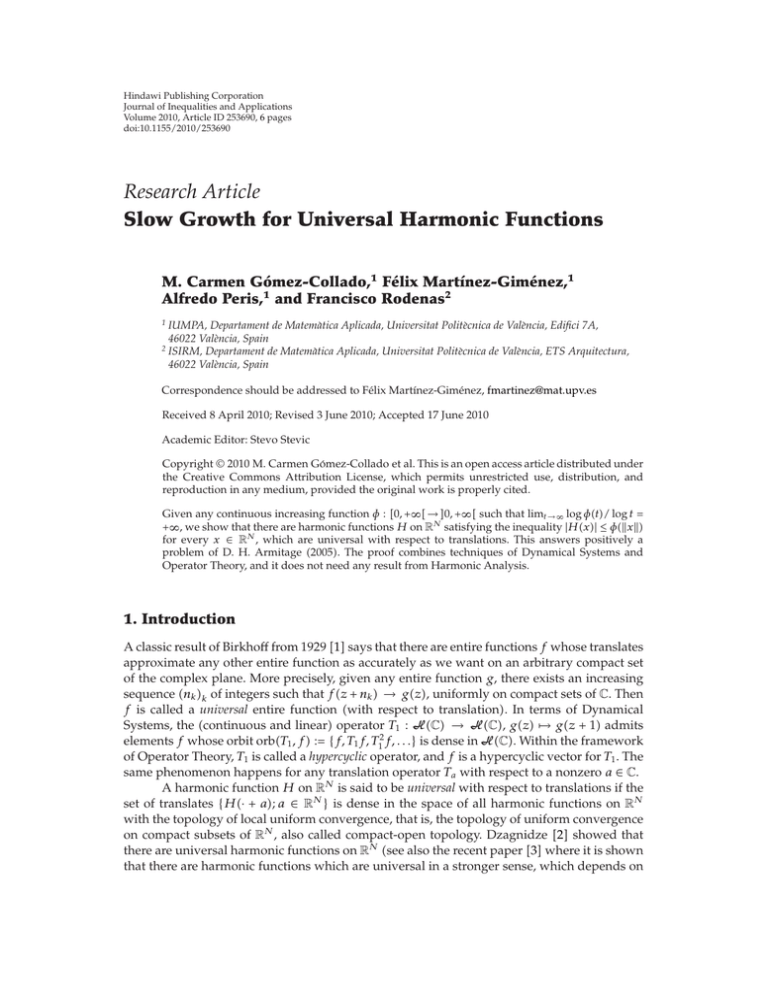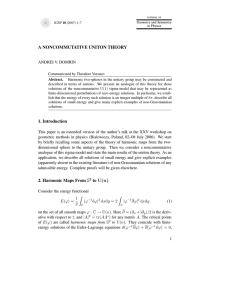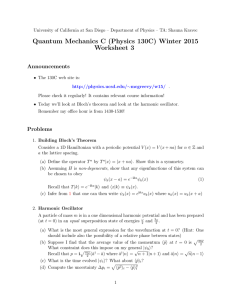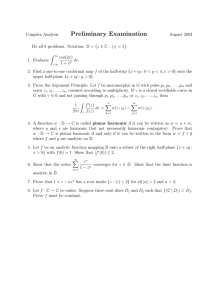Document 10941701
advertisement

Hindawi Publishing Corporation
Journal of Inequalities and Applications
Volume 2010, Article ID 253690, 6 pages
doi:10.1155/2010/253690
Research Article
Slow Growth for Universal Harmonic Functions
M. Carmen Gómez-Collado,1 Félix Martı́nez-Giménez,1
Alfredo Peris,1 and Francisco Rodenas2
1
IUMPA, Departament de Matemàtica Aplicada, Universitat Politècnica de València, Edifici 7A,
46022 València, Spain
2
ISIRM, Departament de Matemàtica Aplicada, Universitat Politècnica de València, ETS Arquitectura,
46022 València, Spain
Correspondence should be addressed to Félix Martı́nez-Giménez, fmartinez@mat.upv.es
Received 8 April 2010; Revised 3 June 2010; Accepted 17 June 2010
Academic Editor: Stevo Stevic
Copyright q 2010 M. Carmen Gómez-Collado et al. This is an open access article distributed under
the Creative Commons Attribution License, which permits unrestricted use, distribution, and
reproduction in any medium, provided the original work is properly cited.
Given any continuous increasing function φ : 0, ∞ → 0, ∞ such that limt → ∞ log φt/ log t ∞, we show that there are harmonic functions H on RN satisfying the inequality |Hx| ≤ φx
for every x ∈ RN , which are universal with respect to translations. This answers positively a
problem of D. H. Armitage 2005. The proof combines techniques of Dynamical Systems and
Operator Theory, and it does not need any result from Harmonic Analysis.
1. Introduction
A classic result of Birkhoff from 1929 1 says that there are entire functions f whose translates
approximate any other entire function as accurately as we want on an arbitrary compact set
of the complex plane. More precisely, given any entire function g, there exists an increasing
sequence nk k of integers such that fz nk → gz, uniformly on compact sets of C. Then
f is called a universal entire function with respect to translation. In terms of Dynamical
Systems, the continuous and linear operator T1 : HC → HC, gz → gz 1 admits
elements f whose orbit orbT1 , f : {f, T1 f, T12 f, . . .} is dense in HC. Within the framework
of Operator Theory, T1 is called a hypercyclic operator, and f is a hypercyclic vector for T1 . The
same phenomenon happens for any translation operator Ta with respect to a nonzero a ∈ C.
A harmonic function H on RN is said to be universal with respect to translations if the
set of translates {H· a; a ∈ RN } is dense in the space of all harmonic functions on RN
with the topology of local uniform convergence, that is, the topology of uniform convergence
on compact subsets of RN , also called compact-open topology. Dzagnidze 2 showed that
there are universal harmonic functions on RN see also the recent paper 3 where it is shown
that there are harmonic functions which are universal in a stronger sense, which depends on
2
Journal of Inequalities and Applications
how “frequently” certain orbits visit any neighbourhood. One may think that the growth
of a universal function cannot be arbitrarily “controlled” from above by certain prescribed
growth. This is certainly the case for polynomial growth since polynomial growth either in
the entire or in the harmonic case implies that the function is a polynomial and, obviously,
the translation of a polynomial is another polynomial of the same degree. But it came as a
surprise that if we fix any transcendental growth, one can find universal entire functions that
grow more slowly 4, 5. In the harmonic case, Armitage 6 showed that universal harmonic
functions can also have slow growth. More precisely, given any φ : 0, ∞ → 0, ∞, a
continuous increasing function such that
log φt
lim ∞,
t → ∞ log t 2
1.1
then there is a universal harmonic function H on RN that satisfies |Hx| ≤ φx for all x ∈
RN . Armitage 6 asked whether the condition 1.1 can be relaxed: is it true that, for every
N > 2, one can find universal harmonic functions on RN with arbitrarily slow transcendental
growth? In other words, can the exponent 2 of log t be reduced to 1? We answer positively
this question. It is easy to notice that limt → ∞ log φt/ log t ∞ is equivalent to saying that
limt → ∞ φt/tk ∞ for all k ∈ N, and no universal harmonic function H can satisfy that
lim supx → ∞ |Hx|/xk < ∞ for any k ∈ N, since this would force H to be a polynomial.
This is why we can only consider transcendental growths for universal harmonic functions.
Let us recall that the case N 2 can be obtained as a consequence of the result in 4, 5 as
was noticed in 6 since, for example, the real part of a universal entire function is a universal
harmonic function on R2 .
We will recall some notions. For the basic theory of harmonic functions we refer the
reader to the books 7, 8. For a good source on the theory of hypercyclic operators and related
properties, we refer the reader to 9–12.
A continuous function T : X → X on a metric space X is topologically transitive resp.,
mixing if, for any pair U, V ⊂ X of nonempty open sets, there is n ∈ N resp., n0 ∈ N such that
∅ resp., for every n ≥ n0 . We will work with continuous and linear operators
T n U ∩ V /
T : X → X on separable, metric, and complete topological vector spaces X. In our framework
it is well known that topological transitivity is equivalent to hypercyclicity.
2. Universal Harmonic Functions of Slow Growth and
Strong Approximation of Polynomials
Given a transcendental growth determined by φ : 0, ∞ → 0, ∞, to find universal
harmonic functions H whose growth is bounded by φ i.e., |Hx| ≤ φx for all x ∈ RN ,
it suffices to find a Banach space X consisting of harmonic functions, whose topology is
finer than the topology of uniform convergence on compact sets of RN , containing the
harmonic polynomials, and such that, on the one hand, the translation operator Ta : X → X,
G → G· a, is well-defined, continuous and hypercyclic for every a ∈ RN \ {0}, and on
the other hand every harmonic function in the unit ball of X has a growth bounded by φ.
Indeed, in this case, there are functions H in the unit ball of X whose orbit under Ta is dense
in X, therefore every harmonic polynomial can be approximated in the topology of X by a
multiple of a fixed a /
0 translation of H, and we obtain that the harmonic functions can be
approximated, uniformly on compact sets of RN , by translations of H.
Journal of Inequalities and Applications
3
Theorem 2.1. Let φ : 0, ∞ → 0, ∞ be a continuous increasing function such that
lim
t→∞
log φt
∞.
log t
2.1
Then there is a Banach space X of harmonic functions, whose topology is finer than the topology
of uniform convergence on compact sets of RN , containing the harmonic polynomials, such that the
translation operator Ta : X → X is a (well-defined and bounded) mixing operator, for any a ∈
RN \ {0}, and every H ∈ X with H < 1 satisfies |Hx| ≤ φx for all x ∈ RN .
In particular, there are universal harmonic functions of arbitrarily slow transcendental growth.
Proof. Let us first consider the case N ≥ 3. We fix a ∈ RN \ {0}, and by Da we denote the
corresponding directional derivative operator Da Gx : lims → 0 Gx sa − Gx/s, x ∈
RN . Since Da commutes with the Laplacian, one can easily construct a basis {pn,m }n,m∈N of
the harmonic polynomials such that each pn,m is kn, m-homogeneous with kn, m ≤ n m,
Da p1,m 0, and Da pn1,m pn,m for every n, m ∈ N. To illustrate a particular case, for instance,
let N 3 and a e1 1, 0, . . . , 0. A construction of a basis of harmonic polynomials with
the above conditions is
p1,1 1,
p2,1 x1 ,
p3,1 x12 − x22
,
2
p1,2 x2 ,
p2,2 x1 x2 ,
p3,2 3x12 x2 − x23
, ···
6
···
p1,3 x3 ,
p2,3 x1 x3 ,
p3,3 3x12 x3 − x33
, ···
6
···
p1,4 x2 x3 ,
p2,4 x1 x2 x3 ,
···
···
···
p2,5 x1 x22 − x3 , · · ·
···
···
p1,5 x22 − x32 ,
p4,1 2
x13 − 3x1 x22
, ···
6
p1,6 x22 x3 − x32 x2 , · · ·
···
···
···
p1,7 x23 − 3x32 x2 ,
···
···
···
···
···
···
···
···
···
2.2
Note that the polynomials constructed above are all homogeneous, and we wrote the part of
the basis until degree 3.
We consider a sequence of positive weights v : {vn,m }n,m∈N such that vn,m >
sup{|pn,m x|; x ≤ n m} and vn1,m > vn,m , n, m ∈ N. Let us define the space of harmonic
functions of growth controlled by v as
Xv Hx m
n
αn,m pn,m x; H :
|αn,m |vn,m < ∞ .
m
n
2.3
4
Journal of Inequalities and Applications
The space Xv is continuously included in the space of all harmonic functions on RN
under the compact-open topology. Indeed, if H m n αn,m pn,m , G m n βn,m pn,m ∈ Xv ,
R > 1, and x ≤ R, then
|Hx − Gx| ≤
αn,m − βn,m pn,m x αn,m − βn,m nm<R
nm≥R
kn,m 1
αn,m − βn,m R
αn,m − βn,m vn,m
≤
pn,m R x nm<R
2.4
nm≥R
≤ RR H − G.
It is clear that if we select the sequence v increasing fast enough, we have that every
H ∈ X : Xv with H < 1 satisfies that |Hx| ≤ φx for all x ∈ RN . To prove it, let
δ : φ0 inft∈0,∞ φt > 0. Our hypothesis on φ implies that
φx
∞,
lim x → ∞ pn,m x
n, m ∈ N,
2.5
because each pn,m is a polynomial. Let Rn,m > 0 so that φx > 2nm |pn,m x| if x > Rn,m ,
n, m ∈ N. We suppose that
vn,m > 2 2
sup pn,m x; x ≤ Rn,m ,
δ
Given any x ∈ RN and H |Hx| ≤
m
n
|αn,m |pn,m x x≤Rn,m
δ
|αn,m | vn,m
2
Rn,m
2.6
αn,m pn,m ∈ Xv with H < 1, we have
Rn,m <x
≤
n, m ∈ N.
φx δ
|αn,m | nm < φx.
2
2
<x
2.7
We have that Da : Xv → Xv is a bounded operator which acts as
Da f Da
m
n
αn,m pn,m
αn,m pn−1,m ,
m n≥2
2.8
since vn1,m > vn,m , n, m ∈ N.
1 1
The space Xv is naturally isomorphic to Yv :
vm , where vm : vn,m n and
1 vm : {z zn n ; z : n |zn |vn,m < ∞}, m ∈ N. Via the natural isomorphism, the
operator Da is then conjugated to the following operator on Yv which is the 1 -sum of the
backward shift B:
Lxm m Bxm m ,
where Bxm Bxn,m n xn1,m n≥1 .
2.9
Journal of Inequalities and Applications
5
1
We fix the notation L B. Since the translation operator Ta equals eDa , we thus have that
1
Ta is conjugated to T eL eB . Then we are done if we prove that eL is a mixing operator
on Yv .
Given arbitrary nonempty open sets U, V ⊂ Yv , we fix m ∈ N and pairs Uk , Vk ⊂ 1 vk of nonempty open sets in the corresponding spaces, k 1, . . . , m, such that
m
m
Uk ⊂ U,
k1
Vk ⊂ V.
k1
2.10
The operator eB is mixing on any weighted 1 -space, as was shown in the proof of Theorem
5.2 of 13; therefore we find j0 ∈ N such that ejB Uk ∩ Vk / ∅, k 1, . . . , m, for every j ≥ j0 .
We finally conclude that
T j U ∩ V ⊃
m ejB Uk ∩ Vk / ∅,
k1
2.11
and Ta , being conjugated to T , is a mixing operator.
The case N 2 is even simpler since the basis of harmonic polynomials can be taken
as {pn,m }n∈N,m1,2 such that Da p1,m 0 and Da pn1,m pn,m for every n ∈ N, m 1, 2. The
corresponding space Yv is the direct sum of two weighted 1 -spaces, and a simplification of
the above argument does the job.
Remark 2.2. What we actually showed in the proof of Theorem 2.1 is that there are H ∈ X
with |Hx| ≤ φx for all x ∈ RN such that, for any harmonic polynomial P , there is an
increasing sequence nk k of integers such that Hx nk a → P x in the topology of Xv ,
which is finer than the topology of uniform convergence on compact sets of RN . Moreover, the
function H is universal with respect to translations in the direction of a, a result also stronger
than Armitage’s in the sense that in 6 all translations were allowed for a universal function.
3. Final Comments
It is possible to obtain the main result of the paper by using tensor product techniques
developed in 14. However the proofs seem to be technically much more complicated since
one has to represent the space of harmonic functions on RN as a quotient of a direct sum of
the complete tensor product of spaces of harmonic functions with fewer variables, while we
produced here a, somehow, direct proof. We want to thank Antonio Bonilla for pointing out
to us the possibility of a tensor product approach.
When we fix a nonzero a ∈ RN , one can consider the parametric family of translation
operators {Tta }t≥0 on our space Xv . This is a C0 -semigroup of operators, which we showed to
be hypercyclic on Xv . We refer to 12, 13 for the basic theory of hypercyclic C0 -semigroups.
In 15 we proved that every hypercyclic vector of a C0 -semigroup is shared by all operators
of the semigroup except, obviously, T0 I. In particular, if H ∈ Xv is a universal harmonic
function for Ta , then it is also universal or a hypercyclic vector for Tta for all t > 0. Let
us notice that the inheritance of hypercyclicity by discrete subsemigroups depends strongly
on the fact that the index set is R or R: there are hypercyclic C0 -semigroups of operators
whose index set is a sector of the complex plane and such that no discrete subsemigroup is
hypercyclic 16.
6
Journal of Inequalities and Applications
The operator Ta can be considered as a infinite type differential operator since
Ta eDa . In 17 we develop techniques based on a kind of generalized backward shifts
which allow us to extend the main results in this paper and 5 to other differential
operators, and then we show the existence of harmonic and entire functions of arbitrarily
slow transcendental growth which are universal with respect to some differential operators.
Acknowledgments
This work was partially supported by the MEC and FEDER Projects MTM2007-64222,
MTM2010-14909, and MTM2007-62643. The third author was also supported by Generalitat
Valenciana, Project PROMETEO/2008/101. The authors would like to thank the referees,
whose reports produced a great improvement of the paper’s presentation.
References
1 G. D. Birkhoff, “Démonstration d’un théorème élémentaire sur les fonctions entières,” Comptes Rendus
de l’Académie des sciences, vol. 189, pp. 473–475, 1929.
2 O. P. Dzagnidze, “On universal double series,” Sakharthvelos SSR Mecnierebatha Akademiis Moambe,
vol. 34, pp. 525–528, 1964.
3 O. Blasco, A. Bonilla, and K.-G. Grosse-Erdmann, “Rate of growth of frequently hypercyclic
functions,” Proceedings of the Edinburgh Mathematical Society. Series II, vol. 53, no. 1, pp. 39–59, 2010.
4 S. M. Duı̆os Ruis, “Universal functions and the structure of the space of entire functions,” Doklady
Akademii Nauk SSSR, vol. 279, no. 4, pp. 792–795, 1984 Russian, English translation Soviet
Mathematics—Doklady, vol. 30, pp. 713-716, 1984.
5 K. C. Chan and J. H. Shapiro, “The cyclic behavior of translation operators on Hilbert spaces of entire
functions,” Indiana University Mathematics Journal, vol. 40, no. 4, pp. 1421–1449, 1991.
6 D. H. Armitage, “Permissible growth rates for Birkhoff type universal harmonic functions,” Journal of
Approximation Theory, vol. 136, no. 2, pp. 230–243, 2005.
7 S. Axler, P. Bourdon, and W. Ramey, Harmonic Function Theory, vol. 137 of Graduate Texts in
Mathematics, Springer, New York, NY, USA, Second edition, 2001.
8 S. J. Gardiner, Harmonic Approximation, vol. 221 of London Mathematical Society Lecture Note Series,
Cambridge University Press, Cambridge, UK, 1995.
9 K.-G. Grosse-Erdmann, “Universal families and hypercyclic operators,” Bulletin of the American
Mathematical Society, vol. 36, no. 3, pp. 345–381, 1999.
10 K.-G. Grosse-Erdmann, “Recent developments in hypercyclicity,” RACSAM. Revista de la Real
Academia de Ciencias Exactas, Fı́sicas y Naturales. Serie A. Matemáticas, vol. 97, no. 2, pp. 273–286, 2003.
11 F. Bayart and É. Matheron, Dynamics of Linear Operators, vol. 179 of Cambridge Tracts in Mathematics,
Cambridge University Press, Cambridge, 2009.
12 K. G. Grosse-Erdmann and A. Peris, Linear Chaos, Universitext, Springer, New York, NY, USA, 2010.
13 W. Desch, W. Schappacher, and G. F. Webb, “Hypercyclic and chaotic semigroups of linear operators,”
Ergodic Theory and Dynamical Systems, vol. 17, no. 4, pp. 793–819, 1997.
14 F. Martı́nez-Giménez and A. Peris, “Universality and chaos for tensor products of operators,” Journal
of Approximation Theory, vol. 124, no. 1, pp. 7–24, 2003.
15 J. A. Conejero, V. Müller, and A. Peris, “Hypercyclic behaviour of operators in a hypercyclic C0 semigroup,” Journal of Functional Analysis, vol. 244, no. 1, pp. 342–348, 2007.
16 J. A. Conejero and A. Peris, “Hypercyclic translation C0 -semigroups on complex sectors,” Discrete and
Continuous Dynamical Systems. Series A, vol. 25, no. 4, pp. 1195–1208, 2009.
17 F. Martı́nez-Giménez and A. Peris, “Hypercyclic differential operators on spaces of entire and
harmonic functions,” , Preprint.






